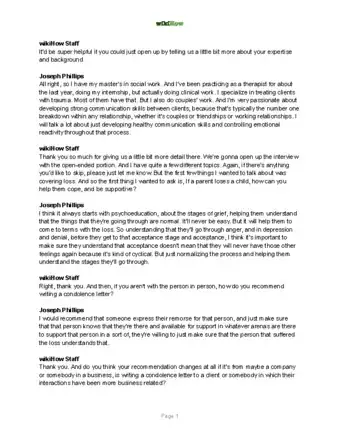This article was co-authored by Joseph Phillips. Joseph Phillips, MSW is a Clinical Therapist and Social Worker at Transformative Growth Counseling, which is based in Illinois and Florida. He specializes in relationship and attachment therapy and treats anxiety, depression, trauma, and substance use. He earned a Master of Social Work from Tulane University in New Orleans, Louisiana, and he completed his clinical internship with Transformative Growth Counseling. Joseph is also certified in disaster and collective trauma counseling.
wikiHow marks an article as reader-approved once it receives enough positive feedback. This article received 14 testimonials and 100% of readers who voted found it helpful, earning it our reader-approved status.
This article has been viewed 293,572 times.
A social work assessment is a report written by a social worker evaluating a client’s educational, mental health, substance abuse, or occupational needs. You will need to interview the client and other significant parties knowledgeable about the client's background and current needs. The final written report includes goals the client should complete to resolve his or her problem and the treatment or assistance the social worker recommends to help the client accomplish these goals.
Steps
Social Work Assessment Template
Gathering information
-
1Schedule interviews. Most of the information that a social worker incorporates into a social work assessment comes from direct reports from all parties involved with a case.
- Begin by interviewing the person who is seeking services. If possible, interview family members, former case workers, physicians, teachers, and other people who can inform you of your client’s situation.
-
2Review documents. You can add to your information by consulting important documents. These might include psychiatric, educational, vocational or medical tests as well as agency records.
- Keep a record of all sources used for your assessment. In the assessment you will want to record who you interviewed, any incidents you were able to observe, and any documents you consulted. [1]
Advertisement -
3Interview clients in a safe atmosphere. The most important part of the assessment process is creating a rapport with your client and other interviewees that would encourage them to divulge information honestly. Focus on obtaining information about the client’s needs and the resources that would help fulfill those needs.
- Create a safe atmosphere when conducting interviews by explaining the rules of confidentiality to the interviewees. In general, all information obtained in the interview will remain a part of the report and that you will not share the information with people who are not involved with the case. If your client doesn't trust you, you will not be able to make a clear assessment.
- To elicit positive responses, focus on finding the strengths of the client. Do not apportion blame. Negotiate with the client over a mutually agreed assessment.[2]
- When you encounter resistance, be optimistic so as not to discourage your client. Continue to be polite, punctual, and attentive. Refrain from using jargon.[3]
-
4Ask open-ended questions. These require the person to respond with detailed answers. Questions requiring only a yes or no answer will not produce enough information for you to write an assessment that can be used to set goals and determine a treatment plan. For example, instead of asking if the client is angry with another individual, ask them to explain how they feel about them.
- Have an assessment form on-hand during your interviews. Assessment forms include specific questions. Using an assessment form will help focus your interview and allow you to take thorough notes. Many facilities have their own assessment forms available for the interview process
Writing the Assessment
-
1Recognize the flexibility of the writing process. There is not necessarily a single way to write an assessment. This can cause trepidation because you will need to find your own voice, but it does allow you to write the report as you think is best for your particular case.
- Include as much information as possible. Describe the client's personal appearance, whether or not the client was appropriately dressed for the weather on the day of the interview, the client's personal hygiene, ability to maintain eye contact, and the client's mental orientation (awareness of person, place, time and event).
- Many facilities have standardized forms that direct you to describe specific questions about the client. One example of categories for an assessment include: “presenting problem,” “problem history,” “personal history,” “substance abuse history,” “family history,” “employment and education,” and “summary treatment and recommendations.”[4]
- Another example of such categories include: “identifying information,” “referral,” “presenting problem,” “sources of data,” “general description of client,” “family composition and background,” “educational background,” “employment and vocational skills,” “religious involvement,” “ health conditions,” “psychological background,” “social, community, and recreation activities,” “basic life necessities,” “legal concerns,” “client strengths,” “clinical summary,” and “goals and recommendations.”
-
2Ascertain the problem. The most basic function of the assessment is to determine what the social worker is trying to accomplish with the client. Reports are often written in a narrative form that tells the story of the client's current problems and how and when those problems initially appeared. It is important to do this in a way that would not offend the client.
- It is often best to refrain from using technical diagnoses, like borderline personality disorder. These can offend the client. Furthermore, they are often not as useful as detailed, specific characterizations of the individual in question.
-
3Find strengths and solutions. You should make an effort to ascertain the strengths and resources of the client, as well as the community that he is part of. Think about how these can be used to improve the client’s condition.[5]
- Set specific goals for the client that are time-limited and attainable. If a goal is to stop using drugs, for example, your treatment recommendation should include a referral to a substance abuse program that requires the client attend a set number of meetings and submit to random drug screenings, and a target date for completion of the program.
-
4Think about the client “ecologically.” Remember that the client is influenced by a wider social “ecology” that includes his family, school, workplace, the community, and the wider sociocultural context. Consider how this contributes to the client’s needs or how the resources of individuals in this wider context can contribute to rectifying problems.[6]
- Compare and contrast the client's perception of his problems, needs, weaknesses and strengths with the perceptions of other people you interviewed for the assessment. Such a comparison can provide you with a more complete understanding of the client's goals and treatment needs.
-
5Use the assessment as part of the therapeutic process. Use the occasion of writing the assessment to think comprehensively about how to improve the client’s situation. Share a summary of the assessment with the client. This can encourage him to reevaluate his situation and might help him reach his own conclusions about how to precede. Try to negotiate a consensus rather than unilaterally imposing your own assessment.
- Schedule a follow up meeting with the client after you've written and discussed the assessment to review the client's progress towards completing each goal. Return to the assessment periodically to evaluate the client’s development
Community Q&A
-
QuestionWhat are the required skills to do an assessment?
 Community AnswerSocial workers require comprehensive interview skills and knowledge about psychological and sociological topics that affect the client.
Community AnswerSocial workers require comprehensive interview skills and knowledge about psychological and sociological topics that affect the client. -
QuestionShould the assessment be written in the first person or third person?
 Community AnswerWrite it in the third person.
Community AnswerWrite it in the third person. -
QuestionWhen writing the report, should I refer to the client as "client" or use their name?
 Community AnswerIt all depends on the rules of your workplace. In most cases, you would refer to the client by their first name only. Some employers prefer "client" or "consumer." Also, some employers allow the use of these interchangeably.
Community AnswerIt all depends on the rules of your workplace. In most cases, you would refer to the client by their first name only. Some employers prefer "client" or "consumer." Also, some employers allow the use of these interchangeably.
Things You'll Need
- A safe, secure interview room
- Medical and educational records
- Assessment form
Expert Interview

Thanks for reading our article! If you'd like to learn more about social work nuances, check out our in-depth interview with Joseph Phillips.
References
- ↑ https://www.proceduresonline.com/stockport/cs/chapters/p_assessment.html
- ↑ https://us.sagepub.com/sites/default/files/upm-binaries/62946_Lishman.pdf
- ↑ https://us.sagepub.com/sites/default/files/upm-binaries/62946_Lishman.pdf
- ↑ https://www.michigan.gov/-/media/Project/Websites/mde/specialeducation/approvals/SSWCompetencyEvaluationForm.pdf?rev=5ece7f91c88e4a57a36b7c0da6221430
- ↑ https://positivepsychology.com/social-work-toolbox/
- ↑ https://us.sagepub.com/sites/default/files/upm-binaries/62946_Lishman.pdf
About This Article
To write an assessment for social work, try to include as much of the information you gathered during your interviews and research as possible so your assessment is specific. You should also mention the issue the client is dealing with, but in a way that won't offend them. Try to focus on the client's strengths and discuss how they can be used to improve their condition. Also, include any recommendations you have for the client and goals you'd like them to work toward. To learn how to gather all of the information you'll need to write your assessment, keep reading!









































































